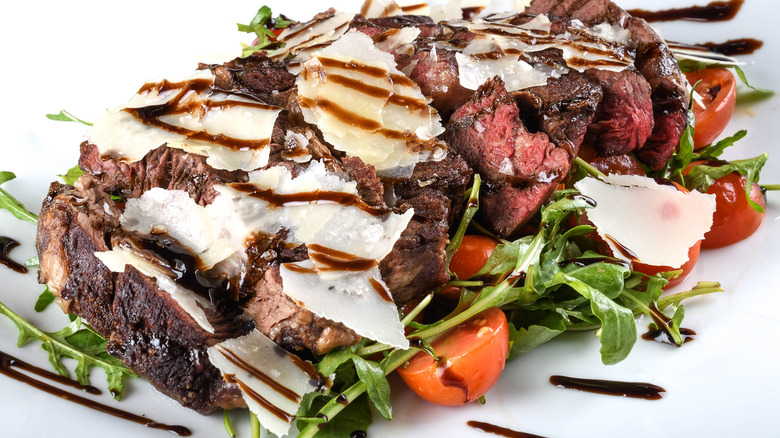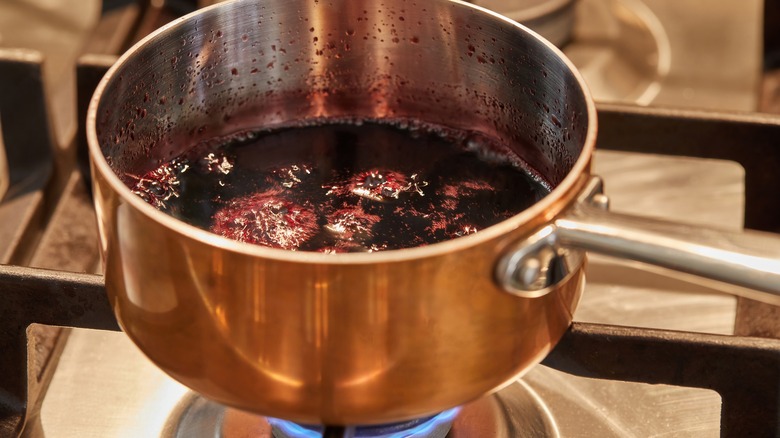What Is A Reduction And What Is It Used For?
When it comes to cooking, there's an entire universal language attached to the process — a myriad of culinary terms used across restaurants, cookbooks, and home kitchens everywhere that refer to various methods or specific outcomes. Within the category of sauces and cooking liquids alone, there are endless words to wrap your head around.
Braising and basting, au jus and au sec, glace and demi-glace, bearnaise and bordelaise: There's a lot to keep track of, but as fancy or as complicated as they may sound, many of these things are simple to execute — and once you understand what they are, they can open up a world of possibility in the kitchen.
You've most likely heard of a reduction. Maybe you've seen it beautifully spread across well-presented plates at gourmet restaurants, or maybe you've tasted its richness in soups or stews without realizing what it was. So let's focus on this one simple term: Something that thankfully sounds like exactly what it is. Let's talk reduction.
What's a reduction and why make one in the first place?
A reduction, by its simplest definition, is a liquid that's been substantially reduced. So to understand what a reduction is, you first need to understand what it means to reduce something when you're cooking. To reduce a liquid is to cook it down until its volume decreases, and its consistency thickens, evaporating some of the water while the seasonings and other ingredients all remain in their original quantities. What's left is a more concentrated, more intensely flavored liquid: A reduction.
It's often the first step or the foundation of a delicious full-bodied soup, stew, sauce, or syrup that rounds out your dish because the main point of a reduction is to add flavor and texture. Because a reduction is such a concentrated version of the original liquid, it's packed with seasoning and flavor that enhances the final result. And because its consistency is thickened, it adds a silky texture to your sauce or more body to the overall meal.
You can create a reduction from one single ingredient or a whole slew of them. For example, balsamic vinegar can be reduced on its own into a balsamic glaze, and you can reduce red wine or other alcohol before adding it to a sauce. Gravy is a reduction made from ingredients like meat drippings, stock, cream, and flour. You can make a fruit sauce reduction to drizzle on a dessert — or reduce a rich pan sauce for a meaty dish. Whichever direction you choose, starting with a reduction will lead somewhere delicious.
How to make a proper reduction
A liquid can be reduced without becoming a reduction — the key to creating a true reduction is to dramatically decrease the liquid's volume. That's why you'll often see recipes and cookbooks that call for something to be "reduced by half," or sometimes even more than that. Typically, a reduction should achieve a consistency that sticks to the back of your spoon. So how do you accomplish this?
To create a thick, flavorful reduction, you'll need to slowly simmer the liquid for an extended period of time (usually around 15-30 minutes, but it can be much longer depending on what you're reducing). This will prevent burning or over-reducing, which is a risk when you try to rapidly boil the liquid. And the key to cooking a reduction is an uncovered pot or pan because you need the steam to be able to escape once it evaporates.
It can be tricky to tell when you've reached the point where your liquid has reduced enough. If you're not sure, you can estimate the change in volume based on sight alone, a helpful trick is to use a jury stick — which can be made by wrapping a rubber band around something like a chopstick and moving it to where the surface of the liquid is when it's inserted into the pot, so you can measure the amount the liquid has reduced.


